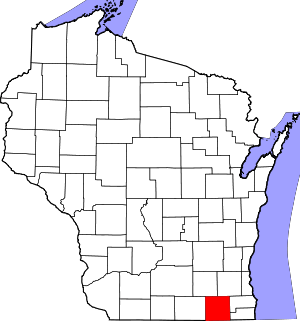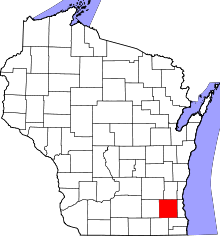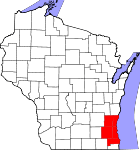Mukwonago, Wisconsin
Mukwonago /mʌˈkwɒnəɡoʊ/ is a village in the U.S. state of Wisconsin. The population was 7,355 at the 2010 census. The village is located mostly within the Town of Mukwonago in Waukesha County, with a small portion extending into the Town of East Troy in Walworth County. Of its population, 7,254 were in Waukesha County, and 101 were in Walworth County.
Mukwonago, Wisconsin | |
|---|---|
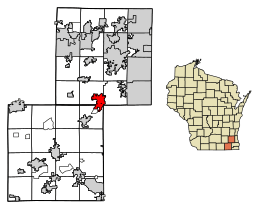 Location of Mukwonago in Waukesha County, Wisconsin. | |
| Coordinates: 42°53′8″N 88°22′5″W | |
| Country | |
| State | |
| County | Waukesha, Walworth |
| Area | |
| • Total | 8.22 sq mi (21.30 km2) |
| • Land | 8.03 sq mi (20.79 km2) |
| • Water | 0.20 sq mi (0.51 km2) |
| Elevation | 978 ft (298 m) |
| Population | |
| • Total | 7,355 |
| • Estimate (2019)[4] | 8,057 |
| • Density | 1,003.74/sq mi (387.54/km2) |
| Time zone | UTC-6 (Central (CST)) |
| • Summer (DST) | UTC-5 (CDT) |
| Zip code | 53149 |
| Area code(s) | 262 Exchange: 363 |
| FIPS code | 55-55075[5] |
| GNIS feature ID | 1583771[2] |
| Website | www |
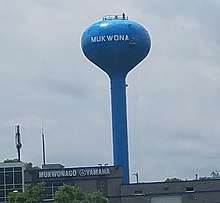
History
The area was originally a Native American village and the tribal seat of the Bear Clan of the Potawatomi Indians. The name "Mukwonago" is derived from "mequanego" which translates to bear's den. The spelling "Mukwonago" was adopted in 1844 because of the similarity to nearby Mequon. Many of the streets and roads are named after the city's founders, such as Ira Blood, Major Jessie Meacham, Sewall Andrews, and Thomas Sugden.[6][7]
Geography
Mukwonago is located at 42°51′52″N 88°19′50″W (42.864557, -88.330619).[8]
According to the United States Census Bureau, the village has a total area of 8.11 square miles (21.00 km2), of which, 7.90 square miles (20.46 km2) of it is land and 0.21 square miles (0.54 km2) is water.[9]
It is situated at the southwestern flank of the sprawling Vernon Marsh, and encircles Upper and Lower Phantom Lake(s). The lakes lie midway along the Mukwonago River from its source springs to its meeting with the Fox River, which travels further southeast through Big Bend and beyond.
Climate
Mukwonago has a hot summer (Köppen Dfb) humid continental climate.
| Climate data for Mukwonago, Wisconsin (all dates) | |||||||||||||
|---|---|---|---|---|---|---|---|---|---|---|---|---|---|
| Month | Jan | Feb | Mar | Apr | May | Jun | Jul | Aug | Sep | Oct | Nov | Dec | Year |
| Record high °F (°C) | 58 (14) |
66 (19) |
82 (28) |
91 (33) |
93 (34) |
100 (38) |
109 (43) |
101 (38) |
101 (38) |
88 (31) |
77 (25) |
68 (20) |
109 (43) |
| Average high °F (°C) | 28 (−2) |
32 (0) |
43 (6) |
56 (13) |
68 (20) |
78 (26) |
82 (28) |
80 (27) |
73 (23) |
60 (16) |
45 (7) |
32 (0) |
56 (14) |
| Source: http://www.weather.com/weather/wxclimatology/monthly/graph/53149 | |||||||||||||
Demographics
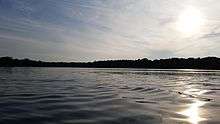
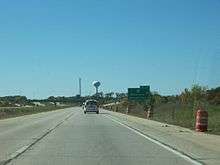
| Historical population | |||
|---|---|---|---|
| Census | Pop. | %± | |
| 1880 | 239 | — | |
| 1890 | 356 | 49.0% | |
| 1910 | 615 | — | |
| 1920 | 697 | 13.3% | |
| 1930 | 846 | 21.4% | |
| 1940 | 855 | 1.1% | |
| 1950 | 1,207 | 41.2% | |
| 1960 | 1,877 | 55.5% | |
| 1970 | 2,367 | 26.1% | |
| 1980 | 4,014 | 69.6% | |
| 1990 | 4,464 | 11.2% | |
| 2000 | 6,162 | 38.0% | |
| 2010 | 7,355 | 19.4% | |
| Est. 2019 | 8,057 | [4] | 9.5% |
| U.S. Decennial Census[10] | |||
2010 census
At the 2010 census there were 7,355 people, 2,923 households, and 2,003 families living in the village. The population density was 931.0 inhabitants per square mile (359.5/km2). There were 3,104 housing units at an average density of 392.9 per square mile (151.7/km2). The racial makeup of the village was 97.4% White, 0.2% African American, 0.2% Native American, 0.9% Asian, 0.1% Pacific Islander, 0.3% from other races, and 0.9% from two or more races. Hispanic or Latino of any race were 3.2%.[3]
Of the 2,923 households 35.6% had children under the age of 18 living with them, 54.9% were married couples living together, 8.6% had a female householder with no husband present, 5.1% had a male householder with no wife present, and 31.5% were non-families. 26.6% of households were one person and 10.7% were one person aged 65 or older. The average household size was 2.50 and the average family size was 3.05.
The median age in the village was 37.9 years. 26.2% of residents were under the age of 18; 7.2% were between the ages of 18 and 24; 28.1% were from 25 to 44; 26.2% were from 45 to 64; and 12.4% were 65 or older. The gender makeup of the village was 48.9% male and 51.1% female.
2000 census
At the 2000 census there were 6,162 people, 2,392 households, and 1,705 families living in the village. The population density was 1,313.3 people per square mile (507.3/km2). There were 2,502 housing units at an average density of 533.3 per square mile (206.0/km2). The racial makeup of the village was 98.21% White, 0.19% African American, 0.24% Native American, 0.36% Asian, 0.29% from other races, and 0.70% from two or more races. Hispanic or Latino of any race were 1.90%.[5]
Of the 2,392 households 35.5% had children under the age of 18 living with them, 57.0% were married couples living together, 9.9% had a female householder with no husband present, and 28.7% were non-families. 22.7% of households were one person and 8.4% were one person aged 65 or older. The average household size was 2.54 and the average family size was 3.00.
The age distribution was 25.5% under the age of 18, 9.9% from 18 to 24, 32.1% from 25 to 44, 21.6% from 45 to 64, and 10.9% 65 or older. The median age was 34 years. For every 100 females, there were 95.2 males. For every 100 females age 18 and over, there were 92.4 males.
The median household income was $56,250 and the median family income was $64,354. Males had a median income of $45,824 versus $28,333 for females. The per capita income for the village was $23,993. About 2.6% of families and 3.1% of the population were below the poverty line, including 3.7% of those under age 18 and 6.4% of those age 65 or over.
Education
The public schools serving Mukwonago are Mukwonago High School, Park View Middle School, Rolling Hills Elementary, Section Elementary, Big Bend Elementary, Eagleville Elementary, Prairie View Elementary, Clarendon Avenue Elementary, and Norris Academy.
Private schools include Mukwonago Baptist Academy, and St. John's Lutheran School.
Notable people
- Marvin H. Bovee, politician
- Timothy T. Cronin, attorney and politician
- James H. Elmore, politician
- Scott Jensen, politician
- Nick Pearson, Olympic speedskater 2002 & 2010 Winter
- Eric Szmanda, actor, CSI
- John J. Van Buren, United States Navy
- Laurel E. Youmans, politician
References
- "2019 U.S. Gazetteer Files". United States Census Bureau. Retrieved August 7, 2020.
- "US Board on Geographic Names". United States Geological Survey. 2007-10-25. Retrieved 2008-01-31.
- "U.S. Census website". United States Census Bureau. Retrieved 2012-11-18.
- "Population and Housing Unit Estimates". United States Census Bureau. May 24, 2020. Retrieved May 27, 2020.
- "U.S. Census website". United States Census Bureau. Retrieved 2008-01-31.
- Wisconsin Historical Society-Origin of Mukwonago, Wisconsin
- Town of Mukwonago, Wisconsin-History
- "US Gazetteer files: 2010, 2000, and 1990". United States Census Bureau. 2011-02-12. Retrieved 2011-04-23.
- "US Gazetteer files 2010". United States Census Bureau. Archived from the original on 2012-01-25. Retrieved 2012-11-18.
- "Census of Population and Housing". Census.gov. Retrieved June 4, 2015.

